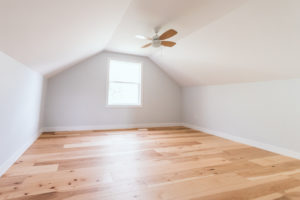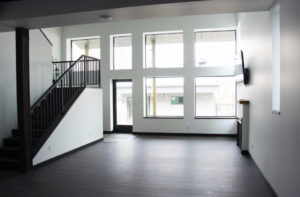Why is there condensation on my windows?
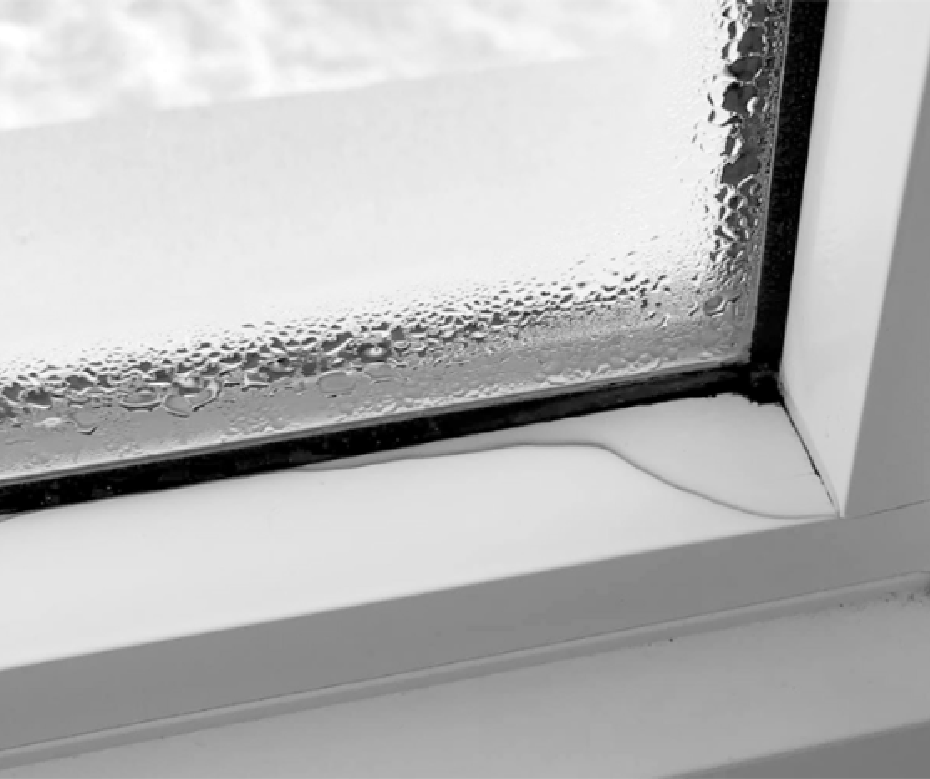
Original Content provided by: Renomark.ca published on 2021/02/10.
It’s a common question asked by Canadians during the winter months.
You may notice below a certain temperature that there’s water accumulating around the edges of your windows or even on the frames themselves.
If it’s cold enough you may even have ice build up or frost on the glass. So, is this a problem with your windows?
Something wrong with the construction of your home? Something wrong with your HVAC system?
The good news is there are steps you can take to reduce the problem, if you take some time to
understand it. First let’s talk about what causes this moisture accumulation.
The physics of condensation
The phenomenon that you’re witnessing is nothing more than some simple physics. Stay with me, you’ve got this!
We know that warm air can hold more moisture than cold air. We also know that if we cool down warm, moist air, we will hit a temperature where that moisture condenses out.
This is called the dew point. Example, humid summer air hitting your cold beverage can. The cold beverage cools the air next to it below the dew point and your can ends up covered with moisture.
What’s happening with your window is the temperature of the glass is low enough to cool the air around it to less than the dew point and the water vapour from the air condenses on the glass.
What leads to window condensation in the winter
The amount of water that collects on your windows determines if it’s a minor nuisance or leaves you with puddles on the floor and structural rot around your windows. There are three factors that affect the amount of moisture and even improving one of them will reduce the amount of condensation.
1. The relative humidity in your home. This percentage is how much moisture is in the air with respect to the maximum the air can hold at that temperature.
2. The amount of air circulation around your window. Lots of air circulation will warm up cool window surfaces, reducing condensation and evaporating any excess that does form.
3. The temperature of the window surface. The colder the surface, the more air is cooled below the dew point, and the more moisture condenses out.
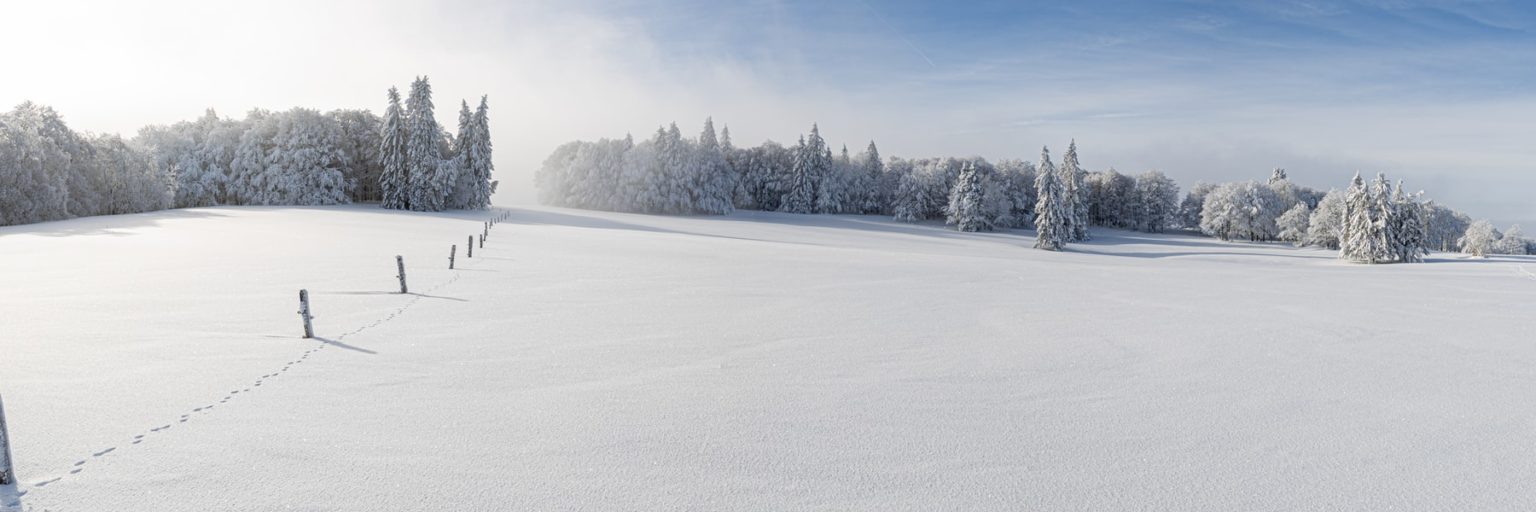
Humidity
Let’s start with humidity, which is the most important thing to control.
If your house is at high relative humidity in the winter, surfaces don’t have to be as cold before condensation forms, so more moisture will condense on more surfaces.
A good humidity level, no matter what time of year, is between 30%-50%, but houses with older, poorly insulating windows may need to stay even lower in very cold weather to avoid condensation.
For most homes, there is either air leaking in and out all the time through gaps in the construction or if it’s a well-built airtight home then it should have a heat recovery ventilator (more on this later).
Since cold winter air doesn’t hold as much moisture as warm air does, any warm air leaking or being vented out takes a lot of moisture with it and any cold air coming in is likely very dry.
If your house loses more
moisture than you generate with cooking and showers, it will feel dry in the
winter. If you generate more moisture than your house loses then the humidity
level will rise, and you could end up with condensation problems.
So how do you measure humidity level?
A digital or smart thermostat may show the humidity level on its display.
If your thermostat doesn’t, there are simple, affordable home comfort monitors you can buy (often less than $20) that will display temperature and humidity.
It’s important to remember these devices will only measure the humidity where they are located so if you have a problem area, you’ll want to start by measuring the humidity in that area.
Some rooms are naturally more humid than others. Bathrooms, laundry rooms, and kitchens have moisture generated from showers, clothes washing, and cooking.
Do you have big tropical plants that you water every day? Plants essentially give off as much water as you water them.
Laundry hanging to dry is another source. Lots of people in a room together will produce a lot of moisture just by breathing… and let’s hope they’re not all speaking moistly!
Areas with more moisture in the air are likely where you’ll first see window condensation. Measure the humidity in any problem areas over a few days to get an average result.
On the opposite end of the scale, you may find your home is too dry in the winter and are using a humidifier to put some moisture back in the air.
This may help with comfort, but if they’re set too high this could be the cause of your excess window condensation or you may get localized problem areas if the humidity isn’t circulated around the house.
Dealing with Humidity
So, if you’ve already turned your humidifier off, cut down on moisture generating activities and switched those tropical plants out for a cactus and you’ve still measuring humidity above 50% in the winter then you may need to ventilate more to remove the humid air.
Remember if you have older or poorly performing windows you may need to lower your humidity below 30% to prevent condensation if it’s below -20C, so you can only take this so far before causing comfort issues
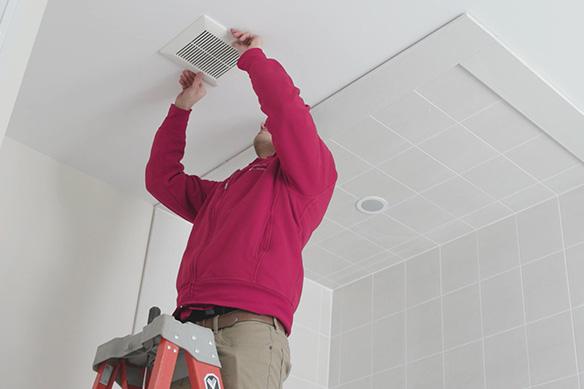



Exhaust Fans
If there is a bathroom fan or a kitchen range hood that exhausts outside, turn these on when someone is showering, doing laundry or cooking.
These fans will help to remove the moist air generated by those activities and reduce the amount of condensation that forms on your windows. The colder it is outside, the more easily condensation will form, so the more important it is to run these exhaust fans.
In an older leaky house with exhaust fans, enough air leaks in naturally through gaps and cracks to replace the air being exhausted and the fans should function to remove humid air.
If you have an airtight house with exhaust fans but no heat recovery ventilator (HRV), then the fans may struggle to exhaust enough air to be effective.
Running your furnace fan at the same time as your exhaust fans will bring fresh air from outside making your exhaust fans more effective and will also help circulate the air in your home.
If it’s not too cold outside, opening a window while the exhaust fans are running will have the same effect.
Keep in mind the cold air coming in to replace whatever is exhausted by these fans will need to be heated up by your furnace.
You don’t want to solve your condensation problem just by racking up huge energy bills, so monitor your humidity and condensation levels and ventilate accordingly.
It may be a good idea to have a timer installed to replace the normal switch for your bathroom fan to allow you to run the fan for the right amount of time without forgetting to turn it off.
Heat Recovery Ventilators (HRVs) and Energy Recovery Ventilators (ERVs)
A Heat Recovery Ventilator (HRV) provides controlled, balanced ventilation for your home.
Balanced means that it exhausts the same amount of stale air as the fresh air it brings in.
The heat recovery part means that it uses heat from the stale air going out to heat up the cold fresh air coming in, so you can ventilate much more efficiently, and your heating system doesn’t need to make up for as much lost energy as a standard exhaust fan.
An Energy Recovery Ventilator (ERV) does the same thing as an HRV, but it also recovers a portion of the humidity from the exhaust air and transfers it to the cold and often very dry fresh air coming in.
This may seem counter productive if you’re trying to get rid of humidity but in a cold dry climate it will allow you to ventilate your home efficiently and comfortably without drying it out too much which may mean you don’t need a humidifier for comfort reasons.
Many modern well-built homes should already have either an HRV or an ERV and it’s a good idea to install one in any home.
Which one is best will depend on your local climate and how much humidity you need to get rid of.
Either can replace the exhaust fan in your bathroom or laundry to help control the humidity in your home and reduce condensation while providing fresh air much more efficiently than standard exhaust fans.
If humidity isn’t the issue
Usually, condensation on your windows is caused by excess humidity, so it’s always best to check the humidity levels in your home before assuming anything else is wrong.
However, if you’ve lowered your home’s humidity as much as you’re comfortable with and you are still seeing condensation or frost on your windows, it’s possible there are other problems.
Air Circulation
The key point here is to differentiate between air circulation right at a window and overall ventilation in your home.
Good air circulation at the window will transfer heat to the glass and keep it warm enough to prevent condensation. You may have a well insulated home with good windows and good ventilation but if you have a window with poor air circulation you may still have condensation in cold weather.
If you have a poorly ventilated home, old windows, and blocked air circulation around your windows, you will likely have puddles of water or thick layers of ice on the glass!
Anything that blocks airflow traps a pocket of cold air next to the glass. The glass and window frame cool off even more as they lose heat to the outside and unless you’ve sealed off the area completely, the cooler pocket of air still has moisture which will condense on the glass.
Blinds or tightly closed curtains will cause this, but it could be anything that slows down the natural air circulation against the glass. A tall couch against a low windowsill or even the screens on an operable window may contribute.
If you leave a throw pillow on your windowsill on a cold night and you may find it frozen to the glass in the morning!
So, remove any window screens for the winter, open blinds or curtains at least slightly, remove objects from your windowsills and move any furniture in front of your windows a few centimeters away from the wall to promote natural air circulation.
You want a clear path for air to naturally flow from ceiling to the floor across the window.
In many houses you will notice that there is often a source of heat directly below the window, a furnace duct or possibly an electric baseboard heater.
If the path is clear, the warm air from the heat source will flow up across the window and warm the glass preventing condensation and helping to evaporate any that might form.
If this is blocked or redirected the air circulation will be reduced and could cause excess condensation to form.
Improving natural air circulation is probably one of the quickest fixes you can do for condensation but there are limits if you still have excess humidity or if your windows are very cold.
Also keep in mind that while air circulation can prevent condensation problems it also increases heat loss, just like increasing ventilation.
Blowing a fan at an old window may keep it free of ice but all that heat you’re transferring to the glass to keep it warm is just going right outside.
Surface Temperatures
The Any surface that is exposed to the air in your home and is below the dew point temperature can form condensation.
If the surface is cold enough, that condensation may freeze and if it’s this cold, it will be difficult to lower the humidity level enough or provide enough air circulation to prevent all condensation.
Cold surface temperatures can be caused by poor insulating properties, like older dual pane glass or aluminum frame windows, or they can be caused by cold air leaking through or around part of your window.
If you have older windows with aluminum frames or aluminum spacers between the glass panes, there’s very little you can do to prevent condensation aside from lowering the humidity and promoting as much natural air circulation as possible.
At some point, even if the windows are still sealed well you may have to replace them or live with a certain amount of condensation and heat loss every winter.
If your windows are not sealed well it may be possible to reduce condensation and certainly improve comfort and energy efficiency by adjusting operable window latches and hinges, replacing weatherstrip or sealing gaps and cracks with silicone to prevent cold air from leaking in around the glass or weatherstrip.
If you notice frost or condensation around the window jambs or on the outside edge of the frame you likely have an air leak between the window and the wall caused by a problem with the installation of the window.
Cold air leaking in here will contribute to more condensation on the glass as the entire frame will be cooled off and could also cause condensation and water damage inside your wall!
Removing the inside window trim at a minimum is required to properly seal and insulate the window but if they were poorly installed in the first place, you may have water leaks or other damage as well and it’s best to call an expert!
What about in new windows
The In most homes with newer windows, reducing humidity, increasing ventilation, and increasing air circulation can all be done for minimal upfront cost and all work well to reduce condensation.
However, they can also have negative impacts on your comfort and energy bills if taken too far to try and compensate for leaky or inefficient windows.
Replacing your windows may be a last resort to solve condensation issues but it will also significantly increase your comfort and reduce your energy bills and greenhouse gas emissions.
If you believe you need new windows it’s best to call in the experts.
The best place to start with any efficiency related renovation is an energy audit. They cost between $300-$500 and will tell you which areas of your home are inefficient or leaky and where you’ll see the best energy or comfort return for your money.
This may include air sealing, upgrading the insulation in your home, selecting upgraded mechanicals like an HRV or ERV, or replacing those old windows.
They will also be able to guide you to any energy efficiency rebates that may be available in your area, including some to help pay for the cost of the energy audit!
If you need new windows, consider selecting more energy efficient triple pane glass to improve comfort and reduce home heating costs.
They use low emissivity coatings on the glass, insulating spacers between the glass panes, gas fillers between the panes and even insulation in the frame cavities to maximize efficiency.
All these features help to reduce energy consumption, emissions, and potential for condensation.
Just as important as the windows themselves is their proper installation to make sure they’re sealed properly to prevent air and water leakage.
When you’re ready to find a renovator, remember to get three quotes and ask for references.
RenoMark Renovators abide by a code of conduct that includes always providing a written contract.
There are renovators out there that specialize in energy efficiency upgrades so make sure you look them up and don’t be afraid to ask lots of questions.
Energy efficiency upgrades can do a lot more than just solve condensation issues.
Energy efficiency upgrades will pay off with reduced costs and emissions and a more comfortable home, all the better to enjoy with a cold beverage from your backyard next summer!
Credits: Jesse Tufts
Original Content provided by: Renomark.ca published on 2021/02/10.
For more information about Butterwick Construction check out our ‘About Us‘ page.
Or for information on our builds visit our ‘How we build‘ page.
Alternatively give our team a call on: 780-434-3559 or email us at: [email protected]

We hope this article written by a member of the Butterwick Construction team, has helped answer the question… Why is there condensation on my windows?




